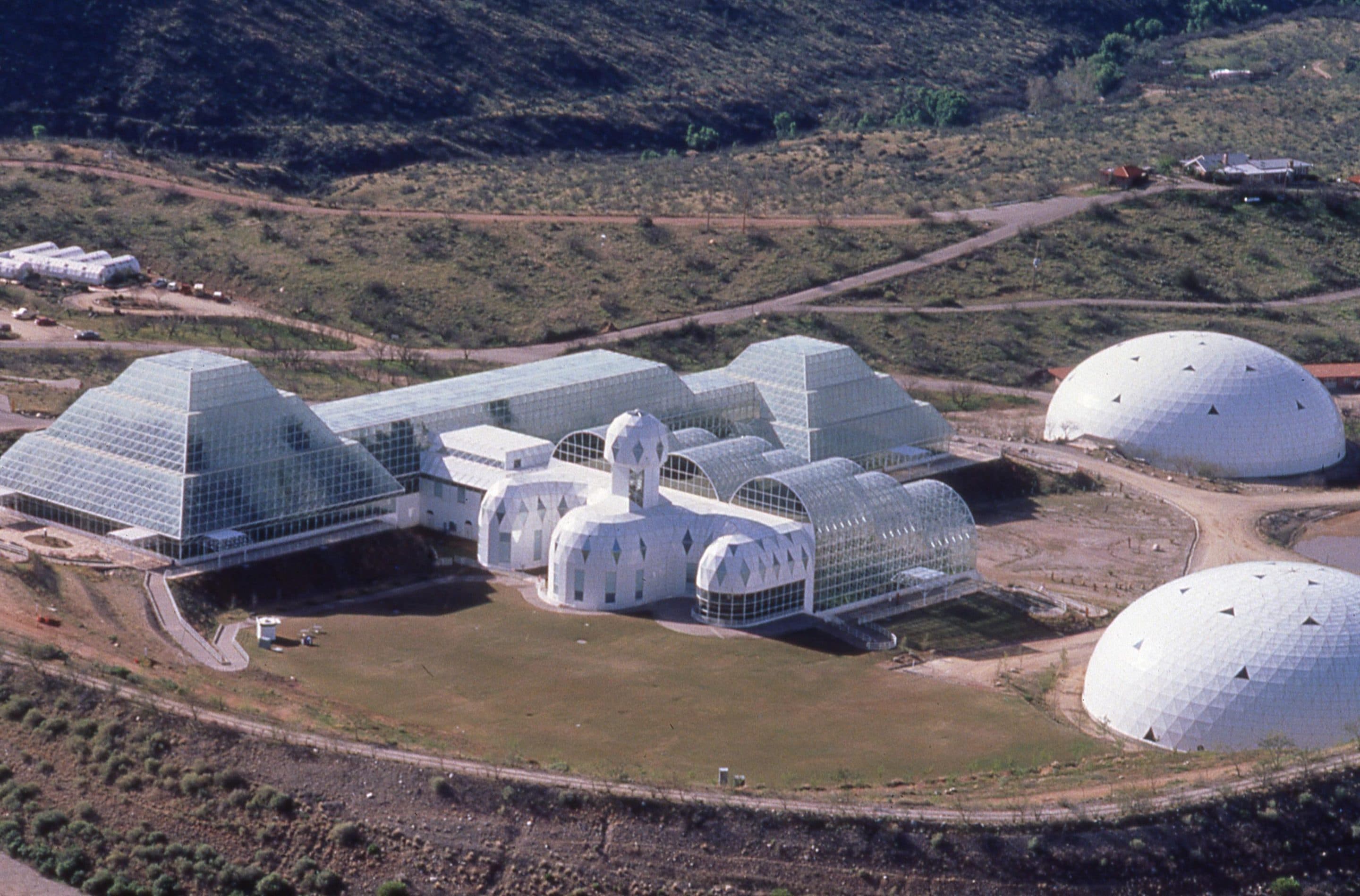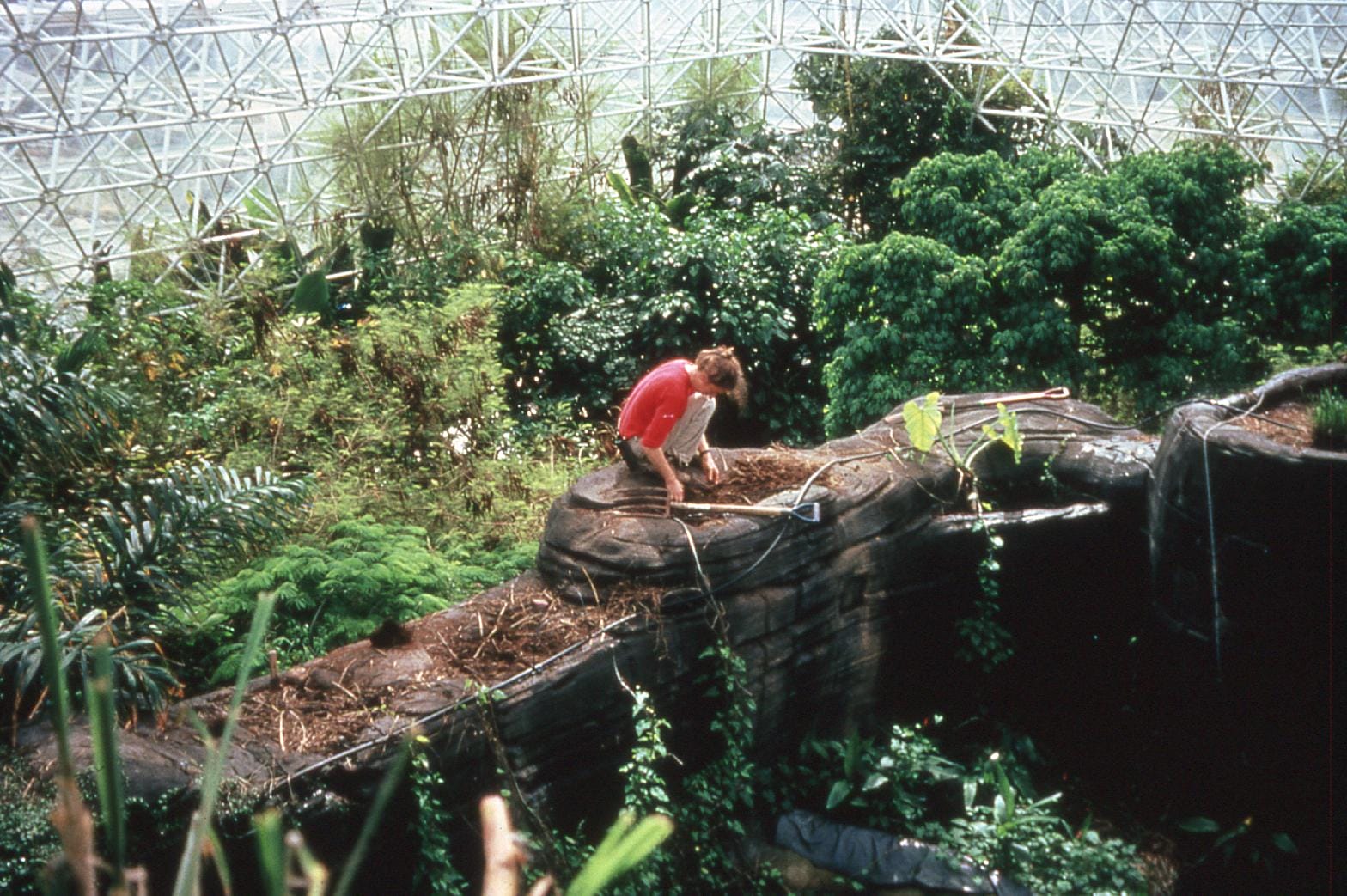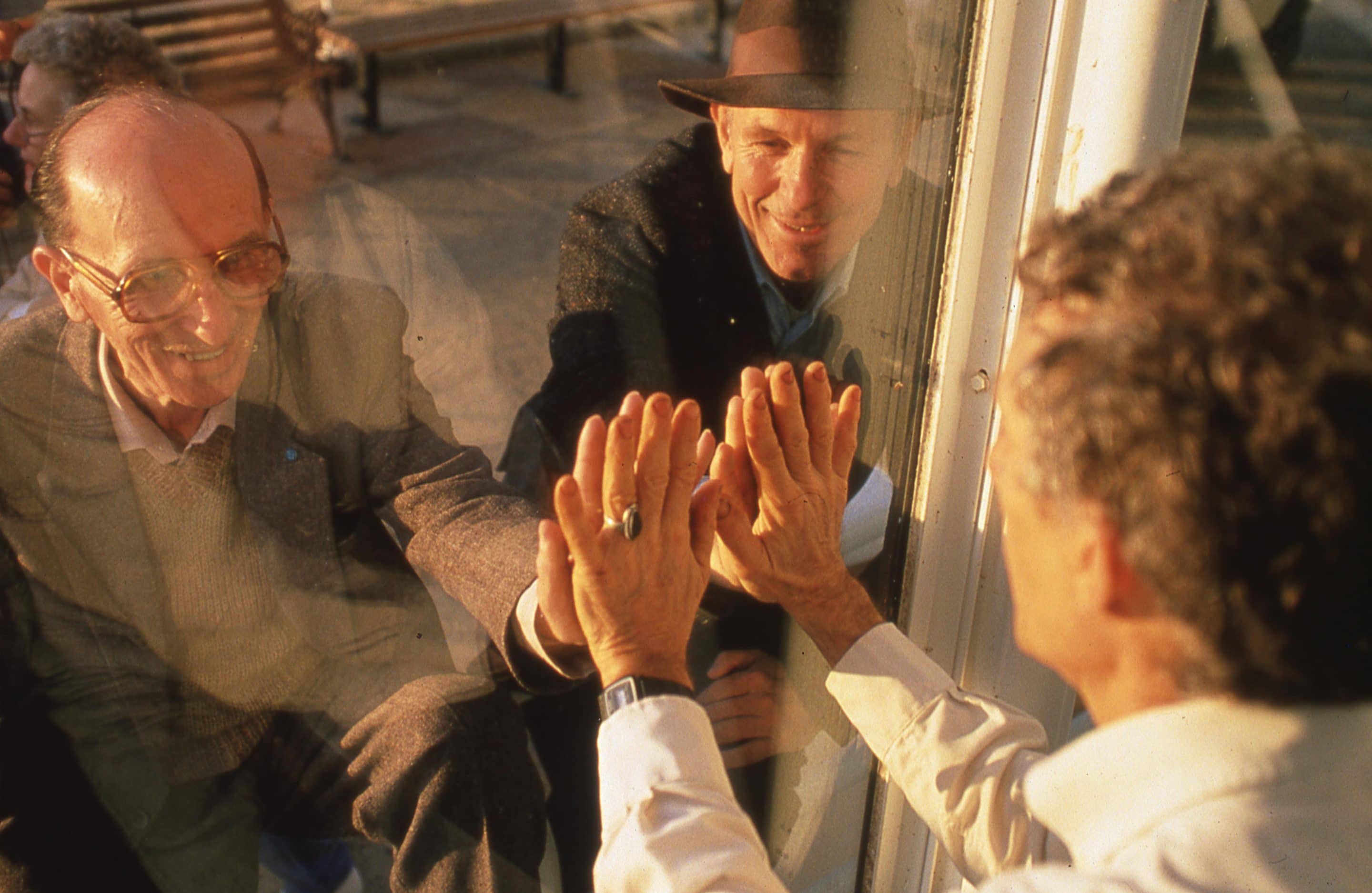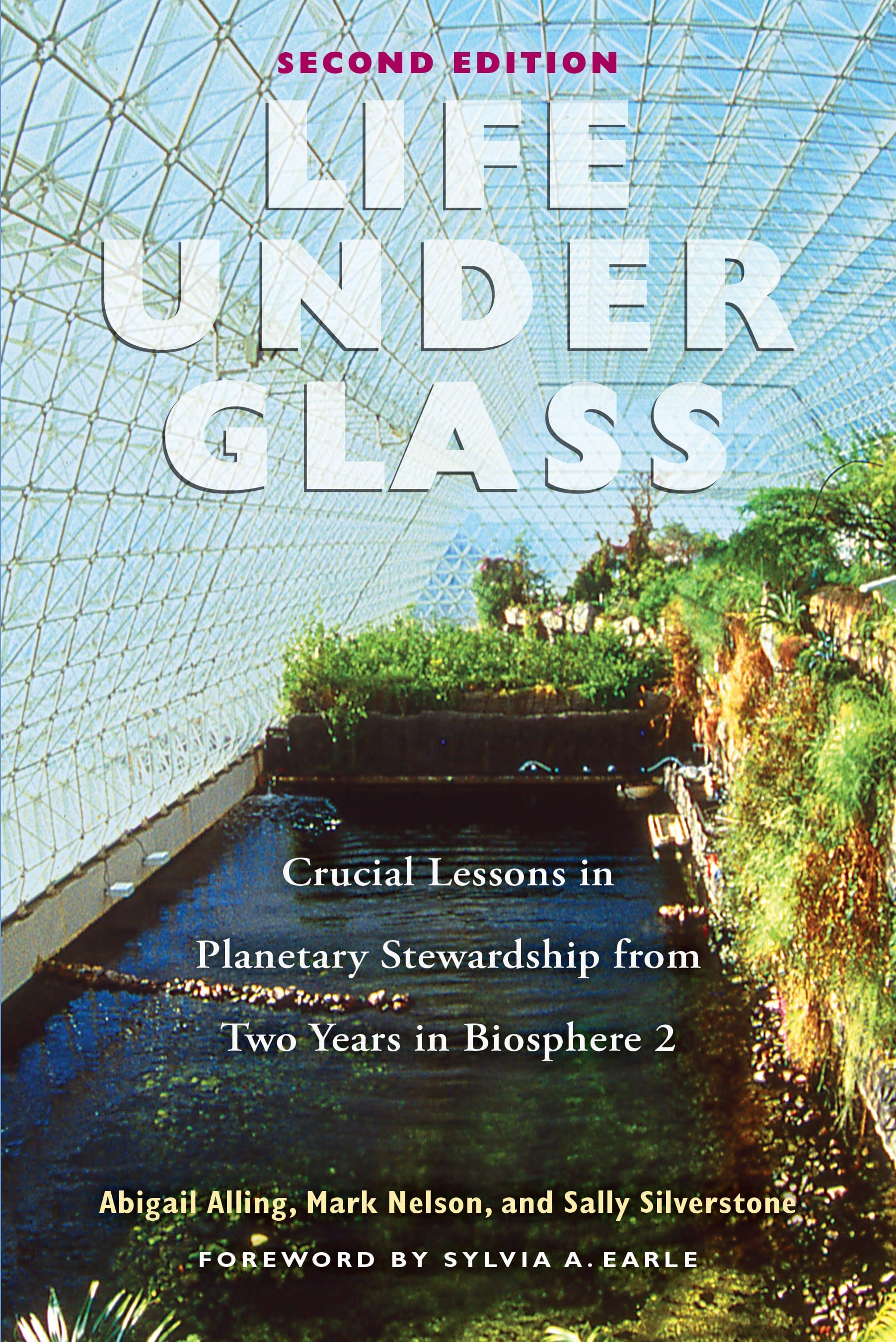Life Under Glass: A Message of Planetary Stewardship
We are excited to announce the soon approaching release of the second edition of Life Under Glass: Crucial Lessons in Planetary Stewardship from Two Years in Biosphere 2 which tells the inside story of Biosphere 2, and what it was like for eight researchers to be sealed in a giant laboratory for twenty-four months.
Despite the fact that the biospherians lived isolated within Biosphere 2, the insights from their vision have leaked far beyond the boundaries of the physical structure, forever changing the lives of the crew members and those that came into contact with it, encouraging them to pursue paths of planetary stewardship.
What was Biosphere 2?

Nestled in the foothills of the Santa Catalina mountains north of Tucson, Arizona, the 3.15 acres Biosphere 2 facility is the world’s largest closed ecological system. Inside are tropical rainforest, savannah, desert, mangrove marsh, coral reef biomes, a half-acre farm, and human living area.
Biosphere 2 consisted of seven biomes within a three-and-a-half acre closed-ecological system built in Oracle, Arizona. Each of the seven biomes was a carefully created replica of one of the various ecosystems on earth, including a tropical rainforest, a savannah, a desert, a marshland , and even an ocean complete with a coral reef! Technologically, architecturally, and ecologically ambitious, it was constructed during 1987-1991, being the largest laboratory for global ecology ever built.
From 1991 to 1993 eight researchers, called ‘biospherians’, undertook an experiment in which they lived fully enclosed within the airtight structure for a period of two years. During this time, the biospherians devoted themselves to caring for their small world, recycling their air, water, and wastes as well as growing their own food.
In Life Under Glass, biospherian crew members, Abigail Alling, Mark Nelson, and Sally Silverstone, present the full account of their remarkable two years living within and caring for Biosphere 2. From the daily struggles of growing their own food, to learning to help sustain their life-giving atmosphere. They give us a sense of how Biosphere 2 caught the world’s imagination, tapping into the desire of people to reconnect and forge a new relationship with our planetary biosphere. Its lessons are increasingly relevant in the Anthropocene era as we find ourselves desperately in search of a new direction.
Learn about steps you can take to protect our Biosphere.
The Earth as a Closed-System
Our home has been under threat for decades from the pressure our expanding technosphere has placed upon the biosphere. In one view, the economic and social structures that we now inhabit have been founded upon the premise of “techno-optimism.” Techno-optimism is predicated around the idea that technological progress and development will be used for the betterment of mankind.
Although, there is truth in the fact that technology has a beneficial impact on many of our lives, its major lack is that technological advancement has not been harmonized with ecological and regenerative practices. To quote R. Buckminster Fuller, “Humanity is acquiring all the right technology for the wrong reasons.”
By contrast, Biosphere 2 was carefully designed using non-polluting technologies to support ecology. Similar to our Earth, Biosphere 2 was a closed-systems ecological unit, and the biospherians deliberately factored out the use of any polluting components such as pesticides and chemical products. They did not take up the “out of sight, out of mind” attitude that is so widely adopted in our world today. Instead, the biospherians understood that any chemical that leaked into the air, water or earth could be dangerous to their health.
“We understood on a profound level that our health and that of Biosphere 2 were the same. We were intensely aware that every action, everything we did, had immediate consequences. Our bodies understood and rejoiced in our cooperation with and dependence on all life. We had our responsibilities to work cooperatively with our living systems so as to maximize their well-being.” — Abigail Alling, Mark Nelson, & Sally Silverstone, Life Under Glass
Living Aboard “Spaceship Earth”
Earlier this year, some of our authors, John Allen and Mark Nelson, attended the Sundance 2020 Film Festival to attend the premiere of the long-awaited documentary film detailing the long, incredible story behind the construction of Biosphere 2. The film, entitled “Spaceship Earth”, is based in part of the memoir of John Allen, Me & the Biospheres, and includes extensive interviews with Mark Nelson and Sally Silverstone.
The title of the film alludes to the concept as used by the visionary architect R. Buckminster Fuller in the mid-1960s. One of Fuller’s primary concerns was the “vision for comprehensive planetary planning that resulted in new strategies intended to enable all of humanity to live with freedom, comfort and dignity, without negatively impacting the earth’s ecosystems or regenerative ability.” John Allen, Biosphere 2 inventor, was close friends with Buckminster Fuller and drew much inspiration from his ideas.
“The notion was to create an enclosed space with every form of habitat — ocean, desert, jungle, and more — to act as an accelerated version of Earth, to show the rest of us how to fix our environmental problems and figure out how to colonize other planets… Wolf chronicles how the idea for Biosphere 2 developed into a real, functioning laboratory project…The copious footage — this was an experiment, and someone wanted it documented — shows how the crew had highs and lows, and dealt with challenges such as the build-up of carbon dioxide in the dome…Though it’s clear Wolf sides with the Biospherians, whom he sees as the first people to illustrate the dangers of climate change, the director is smart enough to present the facts and let viewers draw their own conclusion.” — Sundance review: ‘Spaceship Earth’ makes the case for Biosphere 2 as America’s first climate change experiment
Want to learn more about Spaceship Earth? Read: ‘Spaceship Earth’ and Planetary Stewardship

In the rainforest, Linda Leigh reseeds planting pockets of the cloud forest mountain overlooking the lowland forest area. Fast-growing trees formed the initial canopy, protecting light-sensitive ones which will dominate the rainforest as it matures.
The Interdependence of Life on Earth
We live in an extraordinary and delicately balanced biosphere, wholly taking for granted the remarkable processes that supply us with clean water, air, and sustenance. In our modern-day world, it is easy to feel cut off from the interdependent relationships that characterize life on earth, and remaining unconscious of this interconnectivity has come at a high price to the only real home we have.
In these times of unprecedented uncertainty, the outbreak of the novel Coronavirus (COVID-19) demonstrates how unnervingly delicate the balance of human life is on earth. Beyond the health issues associated with this virus, the effects that it is inevitably having on our social and economic system are of equal concern. The nature of ecosystem change is slow, and steady, compared with the immediate crisis of the pandemic we are now facing, making ecological crises seem like something distant, and far away, thus not spurring us into action.
Perhaps the strongest lesson millions of people will learn from the dramatic changes in our daily lives is a more profound appreciation for interconnectedness of all life. We are one species of billions that share one home on this planet.
 Life Under Glass: Crucial Lessons in Planetary Stewardship from Two Years in Biosphere 2
Life Under Glass: Crucial Lessons in Planetary Stewardship from Two Years in Biosphere 2
Abigail Alling, Mark Nelson, and Sally Silverstone, Foreward by Sylvia A. Earle
Planet in a bottle. Eden revisited. Laboratory under glass. The largest self-sustaining closed ecological system ever made. Biosphere 2 is many things to many people. From its half-acre farm to its coral reef to its emerald rainforest—this unique research facility has proven itself a marvel of human engineering and a testament to the human imagination.
For two years, four men and four women lived and worked inside the structure, recycling their air, water, food, and wastes, and setting a world record for living in an isolated environment. But what has this giant glass-and-steel greenhouse been to those most intimately involved with it? What has it meant to the first crew who studied and cared for it? What was it really like to be sealed inside a giant laboratory for twenty-four months?
“Life Under Glass tells the inside story of an extraordinary scientific experiment, one in which a handful of idealistic citizen scientists, at considerable personal risk, volunteered to enter a closed system, Biosphere 2. The audacity of the effort, together with the courage that drove them to persevere, brings to mind that famous quote of Teddy Roosevelt in which he hails not the critics, but those in the arena who strive valiantly, who spend themselves in a worthy cause, and who, if they fail, do so while daring greatly, their faces marred by dust and sweat and blood. — Professor Wade Davis, BC Leadership Chair in Cultures and Ecosystems at Risk, University of British Columbia, Vancouver
Available April 2, 2020. If you wish, you can purchase the book now, and you will be sent an email notification when the book arrives and is being shipped.

 Life Under Glass: Crucial Lessons in Planetary Stewardship from Two Years in Biosphere 2
Life Under Glass: Crucial Lessons in Planetary Stewardship from Two Years in Biosphere 2